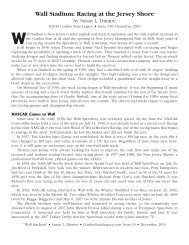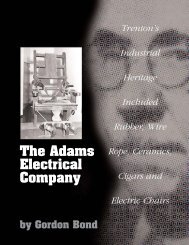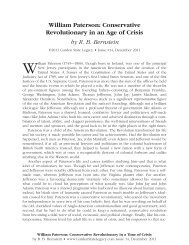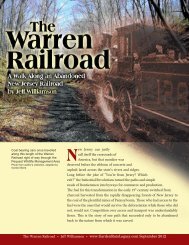David T. Kenny - Garden State Legacy
David T. Kenny - Garden State Legacy
David T. Kenny - Garden State Legacy
You also want an ePaper? Increase the reach of your titles
YUMPU automatically turns print PDFs into web optimized ePapers that Google loves.
By Mary Robinson Sive
How could it be that a woman used a<br />
vacuum cleaner when her town didn’t<br />
have electricity until 10 years later Yet,<br />
this was what I read in a rural woman’s diary<br />
from 1911. Not a carpet sweeper—that<br />
was mentioned earlier. Did she and her husband<br />
perhaps have a generator Possibly—<br />
but wouldn’t she have recorded such a significant<br />
step in her diary that seemed to omit<br />
no detail<br />
It was a puzzle, and I was determined to<br />
solve it. From reference books, the Internet,<br />
and fellow history buffs I learned about the<br />
existence of manual vacuum cleaners before<br />
electric ones. Women in their 70s and 80s<br />
who had grown up on farms remembered<br />
such appliances.<br />
This should not have been surprising.<br />
After all, 90% of farms in the United <strong>State</strong>s—<br />
5 million farms—were without electric service<br />
as late as the mid-1930s. It was only after<br />
World War II that a majority would enjoy such<br />
power. So there was a sizeable market for an<br />
appliance that promised country women that<br />
they could keep up with the kinds of modern<br />
conveniences enjoyed in cities.<br />
Eventually, I got to examine two manual<br />
vacuum cleaners in the possession of a small<br />
historical museum and learned of others in<br />
other small local institutions. But why did<br />
important collections of American home life<br />
not own examples Why was there only one<br />
such object at the Smithsonian Why were<br />
there so many discrepancies in the few<br />
books on American social and cultural—and<br />
women’s—history that even mentioned vacuum<br />
cleaners<br />
A twisting trail led to answers to these<br />
questions. And the trail kept turning up a<br />
name that was also new: <strong>David</strong> T. Kenney<br />
of Plainfield, New Jersey. In 1910 The New<br />
York Times had called him the “father of the<br />
vacuum-cleaner industry.”<br />
The New Jersey inventor is little remembered<br />
today. Some reference books dismiss<br />
him as a “New Jersey plumber” when they<br />
mention him at all. Yet both hand-operated<br />
machines and later electric ones were<br />
dependent on his patents. These expired in<br />
the early 1920s at approximately the same<br />
time as electric units substantially replaced<br />
the manual ones—and the same time as<br />
Kenney’s death by suicide at age 56.<br />
Kenney would be totally forgotten today<br />
had he not been a prominent Catholic layman.<br />
He donated land for the construction<br />
<strong>David</strong> T. Kenney: Forgotten NJ Inventor Mary Robinson Sive <strong>Garden</strong><strong>State</strong><strong>Legacy</strong>.com Issue 8 June 2010
of a girls’ school. in Watchung by the Sisters<br />
of Mercy. Mt. St. Mary Academy continues<br />
today as a prep school, and its archives preserve<br />
papers pertaining to him.<br />
Here is the story of this forgotten New<br />
Jersey native.<br />
Keney’s Early Career<br />
Born to Irish immigrants on a<br />
Whitehouse, NJ, farm in 1866, <strong>David</strong><br />
Kenney at age 15 was apprenticed to a<br />
plumber, and ten years later began his own<br />
plumbing business in Plainfield. His first<br />
inventions, in the 1890s, were for waterclosets<br />
(tanks for flush toilets) that he sold<br />
as a “flushometer.” Enjoying an income<br />
from their manufacture and sale, he soon<br />
joined the many inventors seeking to mechanize<br />
housecleaning.<br />
Mechanical Cleaning<br />
Mechanical cleaning devices had begun<br />
to engage the attention of inventors in the<br />
latter portion of the 19 th century, a period<br />
when carpets and upholstered furniture<br />
came into more common use at the same<br />
time as hygiene was an increasing concern.<br />
Suctioning dust out of a carpet into a closed<br />
<strong>David</strong> T. Kenney: Forgotten NJ Inventor Mary Robinson Sive <strong>Garden</strong><strong>State</strong><strong>Legacy</strong>.com Issue 8 June 2010
container would obviously be more sanitary<br />
than beating the carpet, as was customary<br />
but only spread the dust around. At least<br />
two dozen British and American patents<br />
from the 1850s on, as well as French<br />
and German ones, arose out of such concerns,<br />
some of them suggesting the use of<br />
hand-operated bellows or pulleys, others<br />
employing steam power or gasoline, and<br />
even electricity.<br />
Vacuum Cleaner Patents<br />
Kenney filed his first application for a<br />
cleaning device, mounted on wheels, in<br />
1901, calling it an “Apparatus for Removing<br />
Dust.” This patent was not granted until<br />
1907 though he obtained another one,<br />
applied for later, for a “Separator for<br />
Apparatus for Removing Dust” in 1903.<br />
While pursuing these patents, he installed a<br />
4,000-lb. steam engine in the basement of<br />
the Frick Building in Pittsburgh. It had<br />
attached to it pipes and hoses that reached<br />
into each part of the building to suck<br />
out dust.<br />
About the same time the English engineer,<br />
H. Cecil Booth, demonstrated that suction<br />
could remove dust embedded in<br />
upholstered furniture and probably in carpets<br />
as well. The frequently told account of<br />
his experiment has him placing a freshly<br />
laundered handkerchief on a plush chair<br />
and placing his mouth on it. “I was almost<br />
choked,” he later wrote, when he sucked<br />
in air and a large amount of dust settled on<br />
the back of the handkerchief. Booth built<br />
and marketed a power-driven machine,<br />
coining the term “vacuum cleaner.” He<br />
applied for a United <strong>State</strong>s patent in 1902,<br />
two months after Kenney’s first filing for a<br />
cleaning patent.<br />
The New Jersey man attended a demonstrationof<br />
the English cleaner and after purchasing<br />
a unit bought out Booth’s U.S.<br />
patent application. Once Kenney had the<br />
1907 patent in hand, the Booth application<br />
lapsed. Finding himself bested by a selfeducated<br />
man did not sit well with that gentleman,<br />
as revealed in a protest published in<br />
a trade journal by Booth’s British Vacuum<br />
<strong>David</strong> T. Kenney: Forgotten NJ Inventor Mary Robinson Sive <strong>Garden</strong><strong>State</strong><strong>Legacy</strong>.com Issue 8 June 2010
Cleaner Company many years later.<br />
The U.S. Patent Office was quite<br />
swamped with inventions employing vacuum<br />
technology during those early years of<br />
the 20 th century. Vacuum apparatus, vacuum<br />
cleaner for carpets, vacuum cleaning apparatus,<br />
vacuum cleaning device, vacuum<br />
cleaning implement, vacuum cleaning<br />
machine, vacuum cleaning systems, vacuum<br />
cleaning tool, vacuum dust-remover, vacuum<br />
pan, vacuum producing apparatus,<br />
vacuum-producing device, vacuumsweeper,<br />
and similar terms fill many<br />
columns in annual indexes to patents granted<br />
during these years. Portable units, stationary<br />
ones, and some that were motordriven<br />
were envisaged. (Only stationary<br />
installation for an entire building was practical<br />
for motor-driven units until electric<br />
motors small enough for portable machines<br />
were available).<br />
That it took over five years for Kenney’s<br />
1901 application to be granted was due to<br />
its having at first been rejected by the patent<br />
examiner and only being approved on<br />
appeal. His five patent applications filed<br />
from 1904 to 1906 provided for refinements<br />
such as improved nozzles, and implements<br />
suitable for uneven surfaces, an improved<br />
dry separator, and a transparent chamber<br />
allowing for the observation of dust deposited<br />
in water, all of them referring to operating<br />
equipment attached to a central system.<br />
When portable vacuum cleaners began to<br />
dominate the market, he succeeded in having<br />
his patents deemed applicable to their<br />
manufacture as well, as we shall see.<br />
The Vacuum Cleaner Company<br />
Kenney acquired important customers for<br />
his central vacuuming systems. By 1906 display<br />
ads in popular magazines by the<br />
Vacuum Cleaner Company, 427 Fifth Avenue,<br />
New York (“<strong>David</strong> T. Kenney, Pres’t”)<br />
showed an electric central vacuum cleaning<br />
system located in a basement with hoses<br />
reaching into various rooms, said to be in use<br />
in the White House, the New York Times<br />
Building, and elsewhere. He had incorporated<br />
this company in 1903 and assigned his<br />
subsequent patents to it. A building constructed<br />
in 1906 on North Avenue near<br />
<strong>David</strong> T. Kenney: Forgotten NJ Inventor Mary Robinson Sive <strong>Garden</strong><strong>State</strong><strong>Legacy</strong>.com Issue 8 June 2010
Johnston Avenue in North Plainfield’s<br />
Netherwood section as well as other locations<br />
housed its manufacturing operations.<br />
Kenney’s company was chosen to install<br />
the central vacuum operation in the celebrated<br />
Singer building at Broadway and<br />
Liberty Streets in New York, at the time of<br />
its 1908 completion the world’s tallest office<br />
structure. The building actually contained<br />
two vacuum systems, one for general cleaning,<br />
the other for use by tenants during<br />
office hours, a unique rental feature according<br />
to the chief engineer. “Hat and coat renovators”<br />
were included.<br />
The Vacuum Cleaner Company was<br />
reported to have “portable<br />
cleaning apparatus in<br />
Boston, Philadelphia,<br />
Pittsburgh, Chicago, and St.<br />
Louis” but to be in receivership<br />
just two weeks after<br />
completion of the Singer<br />
building. The “portable<br />
cleaning apparatus” presumably<br />
was similar to that pictured<br />
in the company’s 1906<br />
patent application, i.e. operators<br />
and equipment sent out<br />
to a customer’s location. His<br />
Jersey Vacuum Cleaner<br />
Company, located at 129<br />
Brunswick Street, Newark,<br />
offered central installations<br />
and “portable service,” warning, “Do not<br />
allow the use of the dangerous broom!”<br />
The U.S. Treasury Department was among<br />
the institutions that chose Kenney products<br />
for installation in a new building in 1913.<br />
Between 1905 and 1907 the company<br />
grossed over $800,000 according to a 1915<br />
case, leading the judge to call Kenney “almost<br />
the story book inventor,” having allegedly<br />
begun with $500 in 1901. The following year,<br />
in another case, the same judge reiterated<br />
“that Kenney founded the modern art of vacuum<br />
cleaning.”<br />
Litigation<br />
Kenney would not have enjoyed such<br />
success had he not been a shrewd business<br />
man in a highly competitive environment as<br />
well as a skillful inventor. He understood<br />
that the future of his inventions lay in the<br />
legal system as much as at the workbench<br />
and early on chose noted patent attorney<br />
Thomas Ewing, who later served as U.S.<br />
Commissioner of Patents under President<br />
Wilson, to represent him.<br />
No newcomer to the courts, Kenney had<br />
won an 1899 action and a 1905 infringement<br />
suit over one of his water-closet patents.<br />
Many years of contention over patent rights<br />
followed Kenney’s receiving<br />
his “fundamental” vacuum<br />
cleaner patent in 1907, with<br />
him prevailing in almost all of<br />
them. The suits revolved<br />
around the exact dimensions<br />
of nozzles (“renovators”)<br />
used by his competitors, and<br />
in each case upheld “the<br />
value of a narrow slot which<br />
could be readily moved without<br />
sticking to the carpet, or<br />
causing abrasions of the carpet,<br />
and of a sealing contact.”<br />
Defendants relied on various<br />
earlier patents, but judges,<br />
often impressed by the plaintiff’s<br />
self-made status and success,<br />
found those claims of no relevance.<br />
Nearly every case resulted in the defendant<br />
paying license fees to the Vacuum Cleaner<br />
Company, which took in over a quarter million<br />
dollars in such fees between 1909 and<br />
1915, according to testimony in a 1915 case.<br />
The company morphed from manufacturing<br />
to patent-holding.<br />
Industry Control<br />
By 1909 the public could choose from<br />
over a dozen stationary vacuuming systems<br />
and over one hundred portable cleaners.<br />
<strong>David</strong> T. Kenney: Forgotten NJ Inventor Mary Robinson Sive <strong>Garden</strong><strong>State</strong><strong>Legacy</strong>.com Issue 8 June 2010
Consolidation and attempts to achieve<br />
control through trust agreements were the<br />
order of the day in many industries, and an<br />
effort was made (by someone else) to consolidate<br />
the vacuum-cleaning industry. This<br />
failed in 1912, but Kenney before long managed<br />
to achieve a commanding position in<br />
the industry.<br />
In 1911 seven companies attempted to<br />
fight Kenney’s patents but the next year<br />
agreed to accept licenses at 2–1/2%. Two<br />
years later eleven firms formed a Vacuum<br />
Cleaner Manufacturers Association. It and a<br />
similar attempt in 1916 failed to survive<br />
because not all Kenney<br />
licensees were members.<br />
Finally, in 1919<br />
some 20 companies,<br />
representing manufacturers<br />
of both portable<br />
and stationary equipment,<br />
formed a trade<br />
association, in effect<br />
limited to holders of<br />
Kenney patents since<br />
they “are the basic<br />
vacuum-cleaner patents<br />
that have been litigated<br />
and upheld by the<br />
courts.” The patents<br />
expired in the 1920s,<br />
and by then sales of vacuum<br />
cleaners reached<br />
over a million units,<br />
most undoubtedly<br />
electric.<br />
James Murray Spangler’s 1908 patent for<br />
combining a small electric motor with a<br />
cloth bag to contain the suctioned dust was<br />
the first step in the emergence of the<br />
portable vacuum cleaner. William Henry<br />
Hoover purchased the patent, and his promotion<br />
succeeded so wildly that in the<br />
British Isles the household chore is known<br />
as “hoovering.” That Kenney’s patent was as<br />
applicable to hand-held cleaners as to central<br />
systems was the finding of a 1916<br />
appeals court ruling. The growth of “the<br />
commercial vacuum cleaner art” and “that<br />
Kenney . . . was the founder of the present<br />
vacuum cleaner commercial art” was<br />
remarked on in 1915 by the judge in one of<br />
Kenney’s lawsuits.<br />
Manual Vacuum Cleaners<br />
Hoover’s vacuum cleaners were no help<br />
outside large cities since few communities<br />
were served by electric power. Anyone living<br />
on a farm or in a small town who hoped<br />
to clean in a modern manner had to use a<br />
vacuum cleaner operated<br />
by hand. And that<br />
vacuum had to use the<br />
nozzle and other devices<br />
patented by Kenney.<br />
Sears Roebuck offered<br />
manually operated manual<br />
vacuum cleaners<br />
beginning with the Fall<br />
1909 catalog. They were<br />
of three types and<br />
weighed as much as 50<br />
lbs., one of them requiring<br />
two people to operate<br />
it. The smallest<br />
model functioned somewhat<br />
like a bicycle pump<br />
in reverse. The single<br />
operator pushed the<br />
handle down a tube.<br />
When it was pulled<br />
back, dust came up with<br />
it and into a “receptacle” that could be emptied<br />
as needed. As a consequence it was<br />
operational only half the time, but its weight<br />
of only 5 lbs. made this plunger-type the<br />
most popular. The majority of surviving<br />
manual vacuums are of this type. The<br />
Spring 1910 Sears catalog had reminded<br />
readers that “You need a vacuum” to save<br />
time and labor and to promote health.<br />
“Protect the health of your family” had also<br />
<strong>David</strong> T. Kenney: Forgotten NJ Inventor Mary Robinson Sive <strong>Garden</strong><strong>State</strong><strong>Legacy</strong>.com Issue 8 June 2010
een an admonition of Kenney’s Jersey<br />
Vacuum Cleaner Company.<br />
We may well wonder how many manual<br />
vacuums saw actual use. My informants<br />
who grew up in farm homes in the 1920s<br />
and 1930s remembered seeing them but<br />
didn’t actually remember their mothers ever<br />
using them much. Word<br />
may have got around that<br />
they weren’t really “laborsaving<br />
devices” since few<br />
companies still offered<br />
them after 1916, Sears discontinuing<br />
them by 1920.<br />
Electric Household<br />
Vacuum Cleaners<br />
Once portable electrical<br />
vacuum cleaners for use in<br />
private homes were practical—thanks<br />
to Hoover—<br />
they became“ordinary<br />
household implements,” as<br />
the 1911 Encyclopedia<br />
Britannica noted. Vacuum<br />
cleaner sales in the United<br />
<strong>State</strong>s more than doubled<br />
between 1916 and 1918,<br />
going from 11,756 to<br />
24,451. In 1920 1,024,167<br />
units were sold for a total of<br />
$35 million, most undoubtedly<br />
electric. The industry<br />
for whose growth Kenney was given so<br />
much credit by his contemporaries was<br />
well-established.<br />
In 1910 Good Housekeeping magazine<br />
had wondered “Do vacuum cleaners clean”<br />
The magazine was not quite sure, and when<br />
its staff tested a unit a few years later, it<br />
found that it was “not for a delicate<br />
woman”—not surprising for those 50-lb.<br />
manually operated machines. By 1921 all<br />
that had changed. Many electric models<br />
were on the market, including imported<br />
ones, and when the magazine ran a questionnaire<br />
its readers unanimously endorsed<br />
vacuum cleaners.<br />
Kenney’s Civic Involvement<br />
During the long wait for the 1907 patent<br />
Kenney asked the Sisters of Mercy, an order<br />
of Catholic nuns who were his daughter’s<br />
teachers, to pray for him.<br />
His gift of land enabled<br />
Mt. St. Mary’s College,<br />
founded by the order in<br />
1873, to move from<br />
Bordentown to a<br />
Watchung mountain site<br />
near his manufacturing<br />
operations. His donations<br />
beginning in 1905 and<br />
continuing to the end of<br />
his life totaled over 70<br />
acres. He took an active<br />
part in the planning of the<br />
buildings for the school,<br />
which opened in 1908<br />
with elementary and secondary<br />
classes and<br />
included seven girls in a<br />
college department.<br />
Kenney’s generosity<br />
resulted in his being<br />
made a Papal<br />
Chamberlain by Pope<br />
Pius X in 1906.<br />
The income from his<br />
various patents enabled Kenney to pursue<br />
other business interests, including real<br />
estate. The Kenney home was located in an<br />
upscale section though he later moved to a<br />
hotel. He served on the boards of a hospital<br />
and of the Rahway Reformatory in New<br />
Jersey. In 1915 he with his wife and daughter<br />
gave a dance for a debutante, a possible<br />
clue to social ambitions in New York City.<br />
Kenney’s Death<br />
The industry with which he had been identified<br />
for so long being well-established,<br />
<strong>David</strong> T. Kenney: Forgotten NJ Inventor Mary Robinson Sive <strong>Garden</strong><strong>State</strong><strong>Legacy</strong>.com Issue 8 June 2010
Kenney turned his inventive skills to yet<br />
another field, receiving his last patent, for a<br />
heating system designed to improve the distribution<br />
of heat from a wood-burning fire<br />
place, in 1920. In May 1922 his body was<br />
found near Beacon, NY, after he had been<br />
missing about ten days. He had been in ill<br />
health for some years and had recently lost<br />
his wife and a sister.<br />
History’s Neglect<br />
Manual vacuum cleaners are described in<br />
few books dealing with home life or homemaking<br />
during the pre-World War I period.<br />
Women’s history institutions have no photographs.<br />
As noted above, more examples are<br />
found in small local history museums than<br />
in major ones. The Hoover Company’s<br />
Historical Center in Canton, Ohio has a<br />
small number; and a private collector owns<br />
many more and shows a selection on his<br />
website http://vachunter.com.<br />
Booth’s name appears in the British<br />
Dictionary of National Biography and in<br />
biographical reference works dealing with<br />
technology. The vacuum cleaners he<br />
invented and manufactured are held in<br />
London’s Science Museum. Kenney’s name<br />
cannot be found in corresponding American<br />
reference books, the Library of Congress’<br />
“American Memory” or its Prints and<br />
Photographs Collection, nor in the<br />
Smithsonian Institution. He was long forgotten<br />
by the 1980s, when the New Jersey<br />
Inventors Hall of Fame was inaugurated<br />
with names like Edison and Einstein.<br />
Sources<br />
Cooley, Maxwell S., Vacuum Cleaning Systems. Heating and Ventilating Magazine, 1913<br />
Federal Trade Commission. Report on the House Furnishings Industry. 1925<br />
Foy, JessicaH. & Thomas J. Schlereth, American Home Life, 1880–1930: A Social History of Spaces and<br />
Services. Knoxville: University of Tennessee, 1992<br />
Giedion, S., Mechanization Takes Command. New York: Oxford University Press, 1948<br />
Hardyment, Christina, From Mangle to Microwave. Cambridge, UK: Polity Press, 1988<br />
Semsch, Otto F., A History of the Singer Building Construction. New York: Shumway & Beattie, 1908<br />
Strasser, Susan, Never Done: A History of American Housework. New York: Pantheon, 1982<br />
Transactions of the Newcomen Society, 1934–35, vol. 15.<br />
Assistance by the following institutions is gratefully acknowledged:<br />
Hoover Historical Center, 1875 East Maple Street, North Canton, OH 44720–3331<br />
Mt. St. Mary Academy, 1645 Route 22 West, Watchung, NJ 07069<br />
Plainfield Public Library, Plainfield, NJ 07060–2517<br />
<strong>David</strong> T. Kenney: Forgotten NJ Inventor Mary Robinson Sive <strong>Garden</strong><strong>State</strong><strong>Legacy</strong>.com Issue 8 June 2010
















